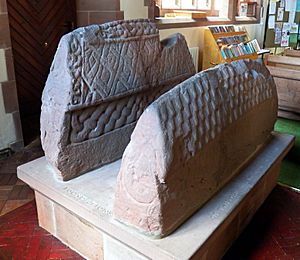Anglo-Scandinavian facts for kids

The term Anglo-Scandinavian describes a cool mix of cultures. It refers to how the Vikings (also called Norse people) and the Anglo-Saxons blended their ways of life in Britain. This happened a long time ago, during the early medieval period.
Historians, archaeologists, and language experts still use this term today. It helps them understand how these two groups influenced each other.
Vikings and people from England had connections for a long time. But there were two main periods when many Vikings settled in England:
- The creation of the Danelaw in the mid-800s. This was an area of England ruled by Vikings.
- The conquests by Viking kings like Sweyn Forkbeard and his son Cnut around the 1010s.
Contents
Anglo-Scandinavian culture is all about how two different groups, the Vikings and the Anglo-Saxons, came together. They shared ideas, traditions, and even their languages. This mixing created something new and unique in Britain.
We can see this cultural blend in many ways. Experts look at old objects, burial sites, and even names to find clues.
Archaeological Discoveries
Archaeologists find special items only in parts of England where Vikings settled. These items are great examples of Anglo-Scandinavian culture.
- Norse bells: These bells are found only in Viking settlements in England. They are not found in Scandinavia itself. This suggests they were a new type of bell created here.
- Hogbacks: These are unique stone grave markers. They look a bit like a house or a hog's back. You won't find hogbacks anywhere else in the Viking world. They are a clear sign of this cultural mix.
Archaeologists also study how people were buried. In the Danelaw, burial styles were very varied. This is different from the more standard ways people were buried in Scandinavia. This variety suggests that new cultural identities were forming. People were creating new traditions, not just copying old ones.
Language Clues
Even the names people used can tell us about this cultural blending. Experts like Lewis-Simpson have studied personal names from the Danelaw. They believe these names show how Viking and Anglo-Saxon languages and traditions mixed.
See Also

